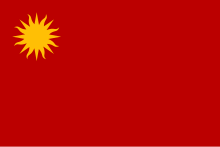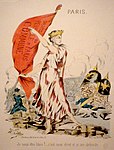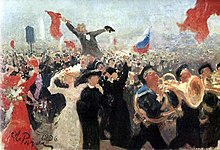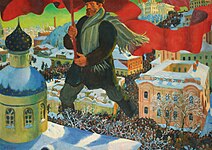Red flag (politics)

In politics, a red flag is predominantly a symbol of socialism, communism, Marxism, trade unions, left-wing politics, and historically of anarchism. It has been associated with left-wing politics since the French Revolution (1789–1799).[1]
Socialists adopted the symbol during the Revolutions of 1848 and it became a symbol of communism as a result of its use by the Paris Commune of 1871. The flags of several socialist states, including China, Vietnam and former Soviet Union, Khmer Rouge, are explicitly based on the original red flag. The red flag is also used as a symbol by some democratic socialists and social democrats, for example the League of Social Democrats of Hong Kong, the French Socialist Party and the Social Democratic Party of Germany. The Labour Party in Britain used it until the late 1980s. It was the inspiration for the socialist anthem, The Red Flag.
Prior to the French Revolution and in some contexts even today, red flags or banners were not associated with socialism, communism, or anarchism, but were seen as a symbol of defiance and battle.[2]
History[]


In the Middle Ages, ships in combat flew a long red streamer, called the Baucans, to signify a fight to the death.[3] In one petition, a group of English sailors asserted that the Crown had no right to a share of the prize money earned from a Norman ship captured in 1293 because it had raised the Baucans.[4] (Raising this streamer may have been a relatively novel practice at this time, since the writers feel the need to explain it.) By the 17th century, the Baucans had evolved into a red flag, or "flag of defiance."[5] It was raised in cities and castles under siege to indicate that they would not surrender.[6] "The red flag is a signal of defiance and battle," according to Chambers Cyclopedia (1727–41).[7]
The red cap was a symbol of popular revolt in France going back to the Jacquerie of 1358. The color red became associated with patriotism early in the French Revolution due to the popularity of the Tricolour cockade, introduced in July 1789, and the Phrygian cap, introduced in May 1790. A red flag was raised over the Champ-de-Mars in Paris on July 17, 1791 by Lafayette, commander of the National Guard, as a symbol of martial law, warning rioters to disperse.[8] As many as fifty anti-royalist protesters were killed in the fighting that followed.
Inverting the original symbolism, the Jacobins protested this action by flying a red flag to honor the "martyrs' blood" of those who had been killed.[9] They created their own red flags to declare "the martial law of the people against the revolt of the court."[10] The Jacobin Club ruled France during the Reign of Terror (1793–1794) and made the red flag an unofficial national emblem.[1] However, the earlier Tricolor never lost its official status and regained popularity under Napoleon.
British sailors mutinied near the mouth of the River Thames in 1797 and hoisted a red flag on several ships.

Two red flags soaked in calf's blood were flown by marchers in South Wales during the Merthyr Rising of 1831. It is claimed to be the first time that the red flag was waved as a banner of workers' power. Along with the Newport Rising eight years later, it was one of the most serious violent outbreaks witnessed on mainland Britain.[11][failed verification] The red flags of Merthyr became a potent relic following the execution of early trade unionist Dic Penderyn (Richard Lewis) in August 1831, despite a public campaign to pardon him.
During the Mexican siege of the Alamo in March 1836, General Antonio Lopez de Santa Ana displayed a plain red flag (approx. 10 feet square) from the highest church tower in Bejar. The meaning of this flag was not socialism: its meaning – directed to the Alamo defenders – meant "no surrender; no clemency."[citation needed]

At much the same time, the Liberal "Colorados" in the Uruguayan Civil War used red flags. This prolonged struggle at the time got considerable attention and sympathy from liberals and revolutionaries in Europe, and it was in this war that Garibaldi first made a name for himself and that he was inspired to have his troops wear the famous Red Shirts.
The Ottoman Empire used a variety of flags, especially as naval ensigns, during its history. The star and crescent came into use in the second half of the 18th century. A buyruldu (decree) from 1793 required that the ships of the Ottoman Navy were to use a red flag with the star and crescent in white. In 1844, a version of this flag, with a five-pointed star, was officially adopted as the Ottoman national flag.
In 1870, following the stunning defeat of the French Army by the Germans in the Franco-Prussian War, French workers and socialist revolutionaries seized Paris and created the Paris Commune. The Commune lasted for two months before it was crushed by the French Army, with much bloodshed. The original red banners of the Commune became icons of the socialist revolution; in 1921 members of the French Communist Party came to Moscow and presented the new Soviet government with one of the original Commune banners; it was placed (and is still in place) in the tomb of Vladimir Lenin, next to his open coffin.[12]
With the victory of the Bolsheviks in the Russian Revolution of 1917, the red flag, with a hammer to symbolize the workers and sickle to symbolize peasants, became the official flag of Russia, and, in 1923, of the Soviet Union. It remained so until the breakup of the Soviet Union in 1991.

After the Communist Party of China took power in 1949, the flag of China became a red flag with a large star symbolizing the Communist Party, and smaller stars symbolizing workers, peasants, the urban middle class and rural middle class. The flag of the Communist Party of China became a red banner with a hammer and sickle, similar to that on the Soviet flag. In the 1950s and 1960s, other Communist governments such as Vietnam and Laos also adopted red flags. Some Communist countries, such as Cuba, chose to keep their old flags; and other countries used red flags which had nothing to do with Communism or socialism; the red flag of Nepal, for instance, represents the national flower.
Eastern Arabia tribal federations used a Red standard as their flag. These federations later developed into sheikhdoms and emirates. The red standard is not related to socialism or communism, but is adopted as one of the early Islamic flags which included a red standard such as the prominent Arab military commander 'Amr ibn al-'As who used a red banner.[13] Examples of Arabian red standards include the flag of the Sultanate of Muscat and Oman, the individual flags of the emirates of the United Arab Emirates, the original flag of Kuwait, Bahrain, and Qatar.
A French soldier takes down a red flag from the barricades during the Paris uprising of 1848.

A poster from the Paris Commune (1871)

A demonstration in Moscow during the unsuccessful Russian Revolution of 1905, painted by Ilya Repin.

Red was the color of the Russian Revolution in 1917. The Bolshevik, painting by Boris Kustodiev (1920).

The flag of the Soviet Union (1923–91). The hammer symbolized workers, the sickle represented farmers, and the red star symbolized the Communist Party.

Flag of the People's Republic of China. Red symbolizes revolution, the large star is the Communist Party, and the smaller stars represent the working class, the farmers, and the urban middle class, the rural middle class, as described by Mao Zedong.

Flag of Socialist Republic of Vietnam. Red symbolizes revolution, the five-point star symbolizes intellectuals, farmers, workers, traders and soldiers.
Symbol of communism and socialism[]
During the 1848 Revolution in France, Socialists and radical republicans demanded that the red flag be adopted as France's national flag. Led by poet-politician Alphonse de Lamartine, the government rejected the crowd's demand: "[T]he red flag that you have brought back here has done nothing but being trailed around the Champ-de-Mars in the people's blood in [17]91 and [17]93, whereas the Tricolore flag went round the world along with the name, the glory and the liberty of the homeland!"[14]

The banner of the Paris Commune of 1871 was red and it was at this time that the red flag became a symbol of socialism and communism. The flag was flown by anarchists at a May Day rally for an eight-hour workday in Chicago in 1886. A bomb blast killed a policeman and the Haymarket Eight were arrested and five were executed. This event, considered the beginning of the revival of the international labor movement, is still commemorated annually in many countries (although not in the U.S.A.). The red flag gained great popularity during the Russian Revolution of 1917.[15] The Soviet flag, with a hammer, a sickle and a star on a red background, was adopted in 1923.[15] Various communist and socialist newspapers have used the name The Red Flag. In China, both the Nationalist Party-led Republic of China and the Communist Party-led People's Republic of China use a red field for their flags, a reference to their revolutionary origins.[citation needed]
In more recent times, social democratic parties have gravitated away from the Red Flag as a symbol.[citation needed] However, several European parties retain a "red square" symbol, including Germany's SPD and the Party of European Socialists. The building to have had a red flag flying for the longest period of time and to still have one is the Victorian Trades Hall in Melbourne, Australia. The flag has been flying for over a century.
Usage by anarchists[]
Anarchists, as part of the socialist movement, also used red flag in the 19th Century – it was one of the first anarchist symbols. Usage of the red flag by anarchists disappeared after the October Revolution, when red flags started to be associated only with communist parties and bureaucratic, reformist and authoritarian social democratic parties.[16]
British Labour Party[]
The red flag was the emblem of the British Labour Party from its inception until the Labour Party Conference of 1986 when it was replaced by a red rose, itself a variant of the "Fist and Rose" then in wide use by left of center parties in Europe. The more floral red rose design has subsequently been adopted by a number of other socialist and social-democratic parties throughout Europe. Members of the party also sing the traditional anthem The Red Flag at the conclusion of the annual party conference. In February 2006 the Red Flag was sung in Parliament to mark the centenary of the Labour Party's founding. The flag was regularly flown above Sheffield Town Hall on May Day under David Blunkett's Labour administration of Sheffield during the 1980s, leading to Sheffield being labelled the People's Republic of South Yorkshire.
Communist and socialist red flag as name or title[]

It has been common to find streets, buildings, businesses and product brands named after the Red Flag in nominally socialist countries as a result of recuperation.[citation needed] For example, a famous line of limousine cars manufactured by China FAW Group Corporation has the brand name of Red Flag. In 1967 during the Cultural Revolution, Pilal in Akto County, Kizilsu, Xinjiang, China was renamed Hongqi Commune (红旗公社), meaning 'red flag commune'.[17] In 1968, Baykurut Commune in Ulugqat County, Kizilsu, Xinjiang, China was also renamed Hongqi Commune.[18][19]
Historical laws banning red flags[]
After the suppression of the 1848 revolution, the red flag and other insignia dominated by the colour red were banned in Prussia, as was the case in France after the demise of the Paris Commune.[20] During the Red Scare of 1919–1920 in the United States, many states passed laws forbidding the display of red flags, including Minnesota, South Dakota, Oklahoma,[21] and California. In Stromberg v. California, the United States Supreme Court held that such laws are unconstitutional.[22]
In Australia the red flag was similarly banned in September of 1918 under the War Precautions Act 1914. This ban would be an arguable cause of the Red Flag riots. The ban ended in Australia with the repeal of the War Precautions Act in 1920.
See also[]
- Bandiera Rossa
- Black flag (⚑)
- Communist symbolism
- Flag of Albania
- Flag of Belarus
- Flag of China
- Flag of Hong Kong
- Flag of Kyrgyzstan
- Flag of North Macedonia
- Flag of the Soviet Union
- Flag of Vietnam
- Green flag
- Hammer and sickle (☭)
- The Red Flag
- Red flag in racing
- Red flag warning
- Red star (★)
- The Standard of Revolt
- White flag
References[]
- ^ Jump up to: a b Brink, Jan ten Robespierre and the Red Terror, (1899).
- ^ Cited in "red flag," Oxford English Dictionary.
- ^ Flags of the World, "Baucans (or Bauccedillian)".
- ^ Marsden, R.G., "Early Prize Jurisdiction and Prize Law in England" (1909)
Perrin, W.G. British Flags: Their Early History and Their Development at Sea; with an Account of the Origin of the Flag as a National Device (1922) p, 161. - ^ 1602 Dekker Satirom. Wks. 1873 I. 233 What, dost summon a parlie, my little Drumsticke? tis too late: thou seest my red flag is hung out.
1666 Lond. Gaz. No. 91/4 That the Red Flag was out, both Fleets in sight of each other, expecting every hour fit weather to Engage.
Flags of the World, "Flag of Defiance." - ^ "so the red flag of defiance was pulled down", Grant, James, Cassell's Old and New Edinburgh, Vol. 1, (1882) p. 49.
- ^ Cited in "red flag," Oxford English Dictionary.
- ^ Thomas Carlyle, French Revolution, p. 408.
- ^ Flags of the World, "French Revolution"
- ^ "Socialist History of the French Revolution"
- ^ Saunders, Bob, "The Merthyr Rising 1831"
- ^ von Geldern, James (1993). Bolshevik Festivals 1917–21. Berkeley: University of California Press. p. 178. Archived from the original on November 26, 2018. Retrieved November 26, 2018.
- ^ Nour, “L’Histoire du croissant,” p. 66/295. See also Ibn Khaldun, Muqaddimah, pp. 214–15.
- ^ Flags of the World, "France"
- ^ Jump up to: a b Flags of the World, "Soviet"
- ^ "Barwy anarchistyczne: Skąd czarne i czarno-czerwone flagi?" [Anarchist colours: Where are black and black-red flags from?]. cia.media.pl (in Polish). Centrum Informacji Anarchistycznej. June 19, 2012. Retrieved September 4, 2016.
- ^ 1997年阿克陶县行政区划 [1997 Akto County Administrative Divisions] (in Chinese). XZQH.org. December 31, 2010. Archived from the original on January 22, 2020. Retrieved September 30, 2020.
皮拉勒乡 1958年成立皮拉勒公社,1967年更名红旗公社,1984年改设皮拉勒乡。
- ^ 乌恰县行政区划和居民地名称 (in Chinese). xjwqx.gov.cn. June 4, 2018. Archived from the original on October 8, 2020. Retrieved October 21, 2019 – via Google Cache, Internet Archive.
- ^ 1997年乌恰县行政区划 [1997 Ulugqat County Administrative Divisions] (in Chinese). XZQH.org. December 31, 2010. Archived from the original on October 15, 2017. Retrieved October 5, 2020.
巴音库鲁提乡 {...}1950年成立巴音库鲁提三乡,1962年建巴音库鲁提公社,1968年更名红旗公社,1984年改设巴音库鲁提乡。
- ^ Balz, Hanno. "'Hostile take-over'. A political history of the red flag". Socialist History. 59: 8–30.
- ^ Zechariah Chafee, Jr., Freedom of Speech (NY: Harcourt, Brace and Howe, 1920), 180ff., Appendix V
- ^ Stromberg v. California, 283 U.S. 359 (1931).
External links[]
| Wikimedia Commons has media related to Red flag. |
- Red flag of Socialism at Flags of the World
- Auguste Blanqui, For the Red Flag, 1848.
- Socialist symbols
- Symbols of communism
- Activism flags
- Political flags
- Red symbols






